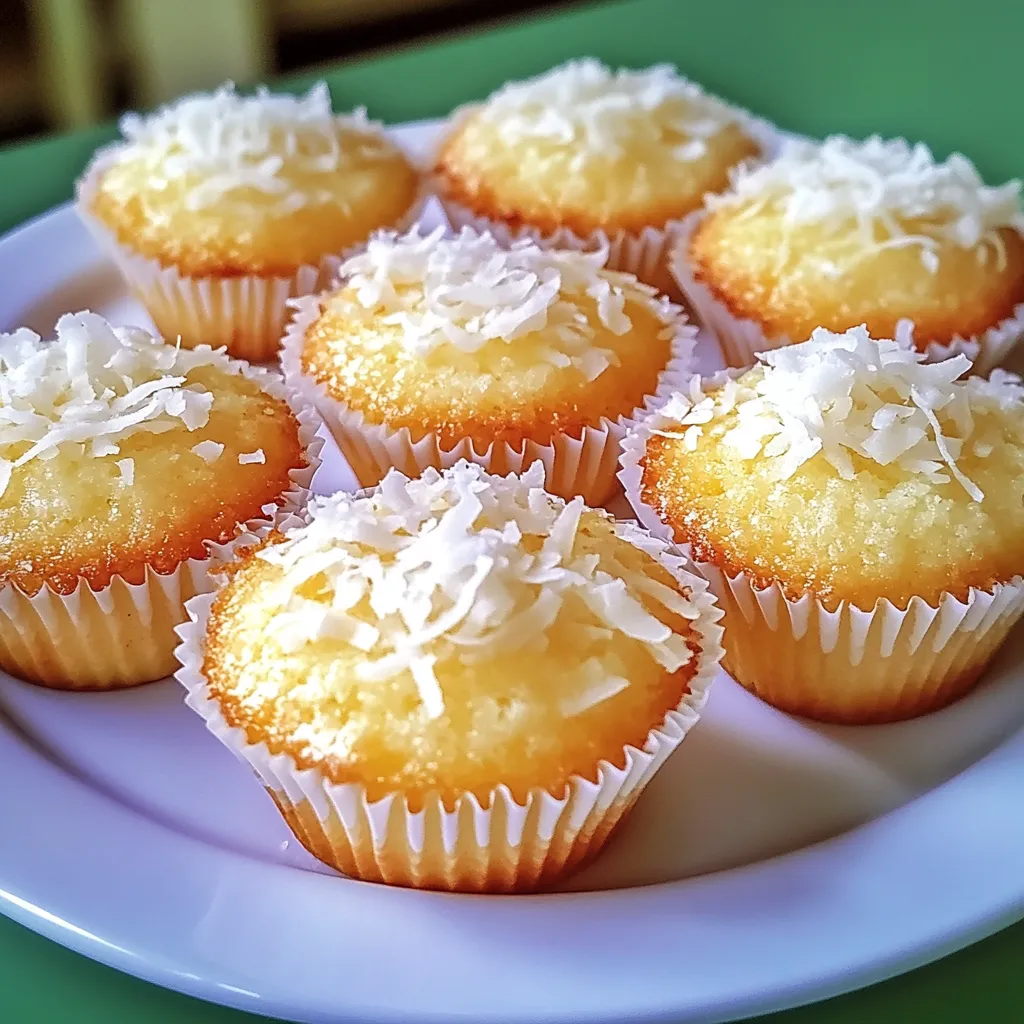 Save
Save
Golden-edged coconut treats with tender, chewy centers create an irresistible texture contrast in these traditional Portuguese sweets that deliver remarkable flavor from just a handful of ingredients. Known as Bolinhos de Coco in their homeland, these naturally gluten-free morsels strike the perfect balance between simplicity and satisfaction, showcasing coconut's natural sweetness in small, perfectly portioned bites. Their rustic appearance belies their sophisticated flavor—a hallmark of Portuguese baking that transforms humble ingredients into something truly special.
Last spring when my Portuguese neighbor brought these to our block party, I was amazed by how something so simple could taste so extraordinary. When she shared her family recipe, I couldn't believe there were only five ingredients. My first batch disappeared so quickly that I now double the recipe whenever I make them. Something about their modest appearance combined with surprising flavor complexity makes them irresistible to everyone who tries them.
Essential Components
- Shredded Coconut: Creates the foundation for both texture and flavor. Unsweetened varieties allow better control over the final sweetness, though sweetened works well with reduced sugar.
- Granulated Sugar: Provides sweetness while contributing to the crisp exterior. Its fine crystal structure dissolves evenly throughout the mixture.
- Eggs: Act as the essential binding agent while contributing richness. Room temperature eggs incorporate more easily for consistent texture.
- Butter: Enhances richness and contributes to golden browning. While optional in traditional recipes, even a small amount adds remarkable depth.
- Vanilla Extract: Rounds out the flavor profile with subtle warmth. Pure extract rather than imitation offers significantly better aromatic quality.
- Salt: Balances sweetness while enhancing coconut's natural flavor. Even this small amount makes a noticeable difference in the final taste.
Baking Method
- Oven Preparation:
- Preheat your oven to 350°F (175°C), positioning the rack in the middle for even heat distribution. Line a baking sheet with parchment paper or lightly grease a mini muffin tin, depending on your preferred shape. This preparation ensures the delicate cakes release cleanly after baking.
- Mixture Combination:
- In a medium bowl, combine shredded coconut, granulated sugar, and a small pinch of salt, stirring to distribute the dry ingredients evenly. This thorough mixing ensures the sugar and salt are evenly distributed throughout the coconut before adding wet ingredients.
- Liquid Integration:
- Add lightly beaten eggs, melted butter (if using), and vanilla extract or citrus zest to the coconut mixture. Stir with a fork or spatula until the mixture becomes cohesive and slightly sticky, with no dry coconut remaining. The mixture should hold together when pressed but still maintain distinct coconut pieces.
- Portion Shaping:
- Using slightly damp hands or a small cookie scoop, form the mixture into small mounds about 1½ inches in diameter. If using a mini muffin tin, fill each cup about two-thirds full, pressing lightly to compact. The moisture from the eggs will help the coconut adhere while baking.
- Baking Process:
- Bake for 15-20 minutes, watching carefully near the end of cooking time. The cakes should develop a beautiful golden brown color on the edges and top while remaining soft in the center. This color contrast indicates perfect texture development—crisp exterior with chewy interior.
- Cooling Strategy:
- Allow the cakes to cool on the baking sheet for 5 minutes to set their structure before transferring to a wire rack to cool completely. This brief resting period prevents them from breaking while still warm and delicate.
- Serving Approach:
- Enjoy these coconut cakes slightly warm or at room temperature, when their texture and flavor are at their peak. Their rustic appearance needs no adornment, though a light dusting of powdered sugar adds elegant presentation for special occasions.
 Save
Save
My first attempt at these cakes taught me an important lesson about coconut varieties. I used very finely shredded coconut, resulting in dense, somewhat dry cakes. When I switched to medium shred as my neighbor suggested, the texture transformed completely—becoming perfectly chewy with distinct coconut strands visible in each bite. This simple adjustment made all the difference in capturing the authentic character of these traditional treats.
Serving Suggestions
These versatile coconut cakes create beautiful harmony with complementary beverages that enhance their subtle sweetness. Serve alongside strong Portuguese coffee or espresso, creating the perfect contrast to the sweet, chewy cakes. For afternoon tea, pair with Earl Grey or a citrusy herbal blend that complements the natural tropical notes of coconut. When entertaining, arrange on a platter with fresh berries or citrus segments for colorful visual appeal and flavor contrast.
Creative Variations
This adaptable recipe welcomes numerous interpretations while maintaining its essential Portuguese character. For chocolate lovers, dip cooled cakes halfway into melted dark chocolate, creating elegant contrast and additional flavor depth. Citrus enthusiasts might incorporate the zest of one lemon or orange into the mixture for bright, aromatic notes throughout. For tropical enhancement, fold 2-3 tablespoons of finely chopped dried mango or pineapple into the mixture before shaping.
Keeping Them Fresh
Store completely cooled coconut cakes in an airtight container at room temperature for up to four days, maintaining both flavor and texture. Separate layers with parchment paper to prevent sticking. For longer storage, refrigerate for up to one week, though allow them to return to room temperature before serving for optimal texture. These cakes freeze beautifully for up to two months—thaw overnight in the refrigerator, then bring to room temperature before enjoying.
 Save
Save
After preparing these Portuguese coconut cakes for countless gatherings and quiet weekend treats, I've found they represent the perfect balance between impressive flavor and practical simplicity. The combination of minimal ingredients with straightforward technique creates a dessert that satisfies deeply while connecting to Portuguese baking traditions. Whether served with morning coffee, afternoon tea, or as a light dessert, these little cakes consistently deliver satisfaction far beyond their humble appearance.
Common Questions About Cooking
- → Can I use unsweetened coconut instead of sweetened?
- Yes, you can use unsweetened shredded coconut, but you'll want to increase the sugar to compensate for the lost sweetness. Try adding an extra 2-3 tablespoons of sugar to the recipe. The texture might be slightly different, as sweetened coconut has more moisture, so your cakes might be a bit drier. If the mixture seems too dry, you can add a tablespoon of milk or a bit of melted butter to help bind it.
- → How do I know when the coconut cakes are done baking?
- The Portuguese coconut cakes are done when the edges and bottoms turn golden brown and the tops begin to get lightly toasted. This usually takes 15-18 minutes in a preheated 350°F oven. Be careful not to overbake them as they can dry out. It's normal for them to be slightly soft when you remove them from the oven - they'll firm up as they cool.
- → Can I add other flavors to these coconut cakes?
- Absolutely! While the traditional recipe is simple, you can add several variations: try adding 1/2 teaspoon of almond extract or coconut extract for more flavor, fold in 1-2 tablespoons of lemon or lime zest for a citrus twist, or mix in 1/4 cup of mini chocolate chips. You could also add a teaspoon of cinnamon or a pinch of cardamom for a warm spice flavor.
- → Can I make these coconut cakes ahead of time?
- Yes, these coconut cakes store well and can be made 2-3 days ahead of time. Let them cool completely, then store in an airtight container at room temperature for up to 4 days. If you live in a humid climate, you might want to refrigerate them to maintain their texture. They can also be frozen for up to 3 months - just thaw at room temperature before serving.
- → Why are my coconut cakes spreading too much during baking?
- If your coconut cakes are spreading too much during baking, there could be a few reasons: your eggs might be too large, adding too much moisture; the coconut might be very moist; or your oven temperature might be too low. To fix this, you can try chilling the formed cakes for 15-20 minutes before baking, adding an extra tablespoon or two of coconut to absorb moisture, or increasing your oven temperature by 25 degrees.
